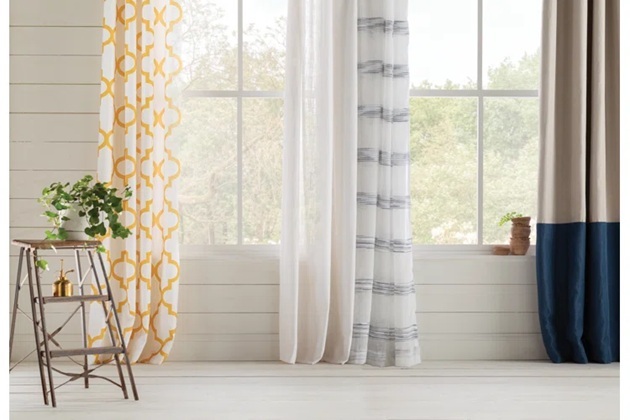Discover the Perfect Curtain Fabrics for a Dreamy Interior
Curtains are one of those home accessories that can instantly elevate the look and feel of a space. They have the power to make a room appear more stylish, sophisticated, and complete. Beyond their decorative appeal, curtains can transform your home into a warmer, more welcoming environment.
What’s even better is that curtains are excellent at preventing allergens and dust from entering your home, acting as a barrier to the outside world. To keep them effective, however, it’s important to wash them regularly.
That said, the ease of washing and maintaining curtains greatly depends on the fabric. This makes it essential to choose your curtain materials wisely.
What Type of Fabric Is Best for Curtains?

When on the hunt for the perfect curtain fabrics for your space, there are several options to choose from. The following are the most popular choices.
Linen
Linen is one of the most popular natural fabrics used for curtains. It’s breathable, antibacterial, hypoallergenic, and has a slightly textured finish that creates a bright and airy aesthetic. Linen works beautifully in spaces where you want a natural, relaxed look.
However, linen’s main downside is maintenance. It doesn’t hold up well to frequent washing and is highly prone to wrinkling. These characteristics can be off-putting to some homeowners looking for a low-maintenance option.
Polyester
While synthetic, polyester remains a top choice for curtains. It’s durable, long-lasting, and easy to wash and care for. Unlike linen, polyester doesn’t wrinkle easily, so there’s no need for regular ironing. It also resists stretching and shrinking.
The main drawback of polyester is its flammability and the lack of warmth and authenticity that natural fabrics provide. It may not deliver the same tactile appeal or eco-friendly feel as options like linen or cotton.
Linen/Polyester Combo
Blending linen with polyester offers the best of both worlds. This popular fabric combination balances natural appeal with synthetic resilience. The result? A durable, mould-resistant, hypoallergenic, and easy-care material that doesn’t wrinkle easily.
Curtains made from a linen/polyester blend are excellent insulators and can be cleaned frequently without the risk of damage. They’re also more affordable than pure linen, making them a practical and stylish choice for most homes.
Cotton
Cotton is another natural fibre that adds warmth and comfort to interiors. It’s breathable, versatile, and suitable for a variety of interior styles, from traditional to contemporary and even Scandinavian. Cotton curtains come in a wide range of colours and patterns, offering plenty of scope for creativity.
However, cotton on its own may not be the most durable choice for curtains. It’s best used in combination with polyester if you want improved longevity and resistance to wear and tear.
Acrylic
Acrylic is a lightweight synthetic fabric that mimics the look and feel of wool. Despite its low weight, it provides good insulation and is known to absorb moisture—ideal for environments prone to condensation.
This fabric is also hypoallergenic and resistant to mould and mildew, making it well-suited for kitchens, bathrooms, or other moisture-prone areas. Acrylic curtains can offer both functionality and style in areas where other fabrics might struggle.
Things to Consider When Choosing
Consider the Room’s Style and Design
When selecting curtain fabrics, it’s important to consider the existing décor and style of the room. Use the room’s colour scheme as a guide to help you choose a fabric that complements the space.
Dark-coloured curtains can lend elegance and depth, but be cautious not to overwhelm the room or make it feel too dim. If you’d like to incorporate colour without sacrificing light, opt for lighter curtains and add visual interest with colourful drapes or tiebacks at the sides.
Think About Natural Light
Light levels are another key factor when choosing curtain fabric. In rooms with limited natural light, go for lighter fabrics in soft, neutral shades. Linen/polyester blends work well here as they allow natural light to filter through while still offering privacy.
For brighter rooms where you’d like to block some of the light, consider thicker fabrics such as velvet or lined cotton. These provide better light control and can help regulate room temperature too.
Don’t Forget the Fabric’s Maintenance
Maintenance should always be part of your decision-making process. Choose a fabric that is easy to clean and can handle regular washing without losing its shape or colour.
A wrinkle-resistant material will also help keep your space looking tidy and polished. If you’re after the perfect balance of easy care and natural appeal, a combination of synthetic and natural fibres, such as linen blended with polyester, is often the most practical option.
By carefully considering the material of your curtains, you can achieve a dreamy interior that’s not only beautiful but functional too. Whether you’re aiming for an elegant finish or a cosy, natural look, the right fabric will help you tie the room together and create a comfortable living space that suits your lifestyle.